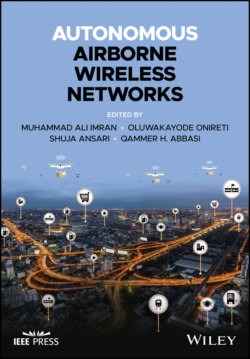Читать книгу Autonomous Airborne Wireless Networks - Группа авторов - Страница 18
2.4.1.1 Path Loss and Large‐Scale Fading
ОглавлениеAir‐to‐Air Channel Free space path loss model is the simplest channel model to represent the AA propagation at a relatively high altitude. Thus, the received power is given by [6]
where denotes the transmitted signal power, and represent the gain of the transmitter and receiver antennas, respectively, is the ground distance between the transmitter and receiver, and is the carrier wavelength. Path loss exponent is the rate of distance‐dependent power loss, where varies with environments. In Eq. (2.2), for free space propagation. Therefore, the distance‐dependent path loss expression can be generalized as
(2.3)
Air‐to‐Ground Channel In urban environment, the AG channel may not experience complete free space propagation. In the existing literature on UAV communications, the log‐distance model is the prominently used path loss model due to its simplicity and applicability when environmental parameters are difficult to define. Therefore, path loss in dB is given by
(2.4)
where is the path loss for the reference distance . For the same propagation distance between the ground device and the UAV, large‐scale variations are different at different locations within the same environment because the materials of obstacles vary from each other, which affects the radio signal propagation. As a result, at any distance , in Eq. (2.1) is the shadow fading measured in dB and modeled as the normal random variable with variance in dB. This model is extensively applied for modeling of the terrestrial channels. Table 2.2 lists some measurement campaigns for the estimations of path loss and large‐scale effects.
Another popular channel model to characterize the AG propagation in UAV communications is the probabilistic path loss model in [4] and [17]. In [17], the path loss between the ground device and the UAV is dependent on the position of the UAV and the propagation environments (e.g. suburban, urban, dense‐urban, high‐rise). Consequently, during the AG radio propagation, the communication link can be either LoS or NLoS depending on the environment. Many of the existing works [18–35] on UAV communications adopted the probabilistic path loss model of [4] and [17]. In these works, the probability of occurrence of LoS and NLoS links are functions of the environmental parameters, height of the buildings, and the elevation angle between the ground device and the UAV. This model is based on environmental parameters defined in the recommendations of the International Telecommunication Union (ITU). In particular, ITU‐R provides statistical parameters related to the environment that determine the height, number, and density of the buildings or obstacles. For instance, in [36], the height of the buildings can be modeled by using the Rayleigh distribution. The average path loss for the AG propagation in [17] is given as
(2.5)
where and are the LoS and NLoS path loss, respectively, for the free space propagation. is the LoS probability given as
Table 2.2 Measurement campaigns to characterize the path loss and large‐scale AG propagation fading.
| References | Scenario | (dB) | (dB) | |
|---|---|---|---|---|
| Yanmaz et al. [8] | Urban/Open field | 2.2–2.6 | — | — |
| Yanmaz et al. [9] | Open field | 2.01 | — | — |
| Ahmed et al. [10] | — | 2.32 | — | — |
| Khawaja et al. [11] | Suburban/Open field | 2.54–3.037 | 21.9–34.9 | 2.79–5.3 |
| Newhall et al. [12] | Urban/Rural | 4.1 | — | 5.24 |
| Tu and Shimamoto [13] | Near airports | 2–2.25 | — | — |
| Matolak and Sun [14] | Suburban | 1.7 (L‐band) | 98.2–99.4 (L‐band) | 2.6–3.1 (L‐band) |
| 1.5–2 (C‐band) | 110.4–116.7 (C‐band) | 2.9–3.2 (C‐band) | ||
| Sun and Matolak [15] | Mountains | 1–1.8 | 96.1–123.9 | 2.2–3.9 |
| Meng and Lee [16] | Over sea | 1.4–2.46 | 19–129 | — |
where and are the constant values related to the environment, is the elevation angle between the ground user and the UAV, is the altitude of the UAV, and is the distance between the ground projection of the UAV and the ground device. According to Eq. (2.6), as the elevation angle increases with the UAV altitude, the blockage effect decreases and the AG propagation becomes more LoS. An advantage of this model is that it is applicable for different environments and for different UAV altitudes. However, it is unable to capture the impact of path loss for AG propagation in mountainous regions and over water bodies due to the lack of information related to their statistical parameters.
Conventional well‐known channel models for cellular communications can be used for UAV communications for UAV altitude between 1.5 and 10 m. One such model for the macro‐cell network was designed for the rural environment by the 3rd Generation Partnership Project (3GPP) in [7,37].
Since LoS and NLoS links are treated separately, the probability of LoS propagation is expressed as
Path loss and large‐scale fading can be calculated once the LoS probability is known from Eq. (2.7). As the communication nodes change their position, path loss also changes and can be found as
(2.8)
(2.9)
where
(2.10)
(2.11)
(2.12)
(2.13)
with , , , and being the carrier frequency, height of ground BS, the average width of street, and the speed of light, respectively.
For the obstructed AG propagation with the UAV altitude between 10 and 40 m, the LoS probability in the rural environment for the macro‐cell network can be computed as [7]
(2.14)
where
(2.15)
(2.16)
The path loss for LoS and NLoS links can be computed as
(2.18)
For a high‐altitude AG channel with , the LoS probability is 1 and the path loss can be formulated as Eq. (2.17).
